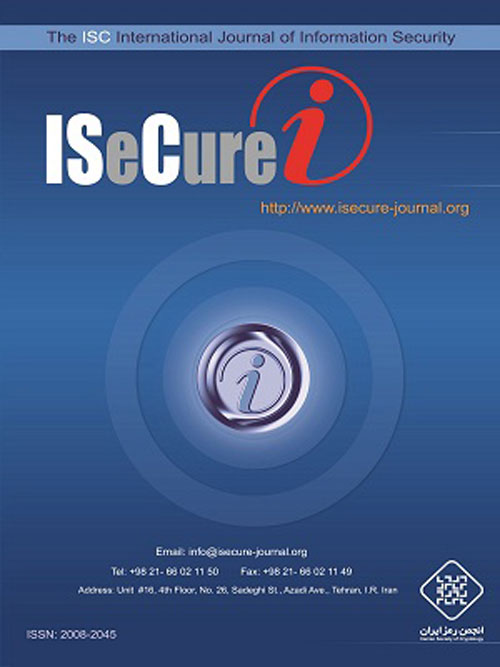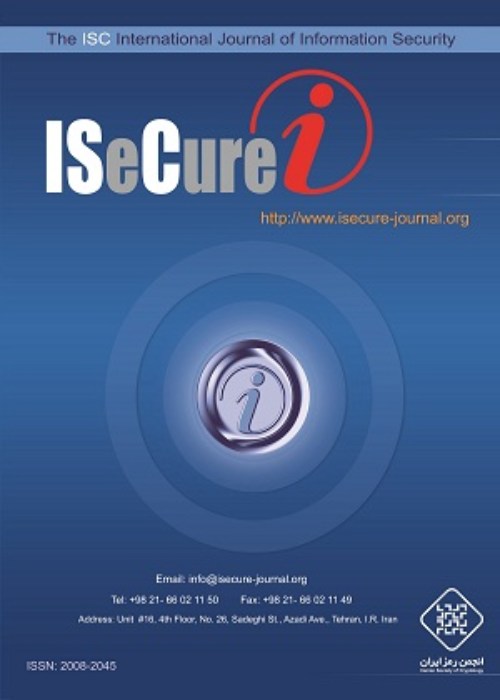فهرست مطالب

International Journal of Information Security
Volume:11 Issue: 2, Jul 2019
- تاریخ انتشار: 1398/04/10
- تعداد عناوین: 7
-
-
Pages 93-94
-
Pages 95-111
In today's highly interconnected networks, security of the entities are often interdependent. This means security decisions of the agents are not only influenced by their own costs and constraints, but also are affected by their neighbors’ decisions. Game theory provides a rich set of tools to analyze such influence networks. In the game model, players try to maximize their utilities through security investments considering the network structure, costs and constraints, which have been set by the network owner. However, decisions of selfish entities to maximize their utilities do not always lead to a socially optimum solution. Therefore, motivating players to reach the social optimum is of high value from the network owner’s point of view. The network owner wants to maximize the overall network security by designing the game's parameters. As far as we know, there is no notable work in the context of linear influence networks to introduce appropriate game design for this purpose. This paper presents design methods that make use of the adjustments of players’ costs, interdependencies, and constraints to align players' incentives with a network-wide global objective. We present a comprehensive investigation of existence and uniqueness conditions of Nash Equilibrium in such environments. Furthermore, numerical results of applying the proposed mechanisms in a sample real-world example are illustrated.
Keywords: Interdependent Security, Nash equilibrium, Social Optimum, Game Design -
Pages 113-128
Smart grid concept is introduced to modify the power grid by utilizing new information and communication technology. Smart grid needs live power consumption monitoring to provide required services and for this issue, bi-directional communication is essential. Security and privacy are the most important requirements that should be provided in the communication. Because of the complex design of smart grid systems, and utilizing different new technologies, there are many opportunities for adversaries to attack the smart grid system that can result fatal problems for the customers. A privacy preserving authentication scheme is a critical element for secure development of smart grid. Recently, Mahmood et al. [1] proposed a lightweight message authentication scheme for smart grid communications and claimed that it satisfies the security requirements. Unfortunately, we found that Mahmood et al.'s scheme has some security vulnerabilities and it has not adequate security features to be utilized in smart grid. To address these drawbacks, we propose an efficient and secure lightweight privacy-preserving authentication scheme for a smart grid. Security of our scheme are evaluated, and the formal security analysis and verification are introduced via the broadly-accepted Burrows-Abadi-Needham (BAN) logic and Automated Validation of Internet Security Protocols and Applications (AVISPA) tool. Finally, the security and efficiency comparisons are provided, which indicate the security and efficiency of the proposed scheme as compared to other existing related schemes.
Keywords: smart grid, Authentication, Privacy Preserving, AVISPA, BAN logic -
Pages 129-143
In this paper, we propose a new method of differential fault analysis of SHA-3 which is based on the differential relations of the algorithm. Employing those differential relations in the fault analysis of SHA-3 gives new features to the proposed attacks, e.g., the high probability of fault detection and the possibility of re-checking initial faults and the possibility to recover internal state with 22-53 faults. We also present two improvements for the above attack which are using differential relations in reverse direction to improve that attack results and using the algebraic relations of the algorithm to provide a second way to recover the internal state of SHA-3. Consequently, we show that with 5-8 faults on average, SHA-3's internal state can be fully recovered.
Keywords: SHA-3, Differential Fault Analysis, State Recovery, differential equations, Algebraic Resolution, Multiple Byte Fault -
Pages 145-158GOST block cipher designed in the 1970s and published in 1989 as the Soviet and Russian standard GOST 28147-89. In order to enhance the security of GOST block cipher after proposing various attacks on it, designers published a modified version of GOST, namely GOST2, in 2015 which has a new key schedule and explicit choice for S-boxes. In this paper, by using three exactly identical portions of GOST2 and fixed point idea, more enhanced fixed point attacks for filtration of wrong keys are presented. More precisely, the focus of the new attacks is on reducing memory complexity while keeping other complexities unchanged as well. The results show a significant reduction in the memory complexity of the attacks, while the time complexity slightly increased in comparison to the previous fixed point attacks. To the best of our knowledge, the lowest memory complexity for an attack on full-round GOST2 block cipher is provided here.Keywords: Cryptanalysis, Fixed Point Attack, Gost2 Block Cipher, Meet in the Middle
-
Pages 159-171
Abstract- With the advancement and development of computer network technologies, the way for intruders has become smoother; therefore, to detect threats and attacks, the importance of intrusion detection systems (IDS) as one of the key elements of security is increasing. One of the challenges of intrusion detection systems is managing of the large amount of network traffic features. Removing unnecessary features is a solution to this problem. Using machine learning methods is one of the best ways to design an intrusion detection system. Focusing on this issue, in this paper, we propose a hybrid intrusion detection system using the decision tree and support vector machine (SVM) approaches. In our method, the feature selection is initially done by the C5.0 decision tree pruning, and then the features with the least predictor importance value are removed. After removing each feature, the least square support vector machine (LS-SVM) is applied. The set of features having the highest surface area under the Receiver Operating Characteristic (ROC) curve for LS-SVM are considered as final features. The experimental results on two KDD Cup 99 and UNSW-NB15 data sets show that the proposed approach improves true positive and false positive criteria and accuracy compared to the best prior work.
Keywords: Intrusion Detection, Feature selection, Support Vector Machines, decision tree -
Pages 173-183Detection of fake accounts on social networks is a challenging process. The previous methods in identification of fake accounts have not considered the strength of the users’ communications, hence reducing their efficiency. In this work, we are going to present a detection method based on the users’ similarities considering the network communications of the users. In the first step, similarity measures somethings such as common neighbors, common neighbors graph edges, cosine, and the Jaccard similarity coefficient are calculated based on adjacency matrix of the corresponding graph of the social network. In the next step, in order to reduce the complexity of data, Principal Component Analysis is applied to each computed similarity matrix to provide a set of informative features. then, a set of highly informative eigenvectors are selected using elbow-method. Extracted features are employed to train a One Class Classification (OCC) algorithm. Finally, this trained model is employed to identify fake accounts. As our experimental results indicate the promising performance of the proposed method a detection accuracy and false negative rates are 99.6% and 0%, respectively. We conclude that bringing similarity measures and One Class Classification algorithms into play, rather than the multi-class algorithms, provide better results.Keywords: Social Networks, Privacy, Fake Accounts, One Class Classification


